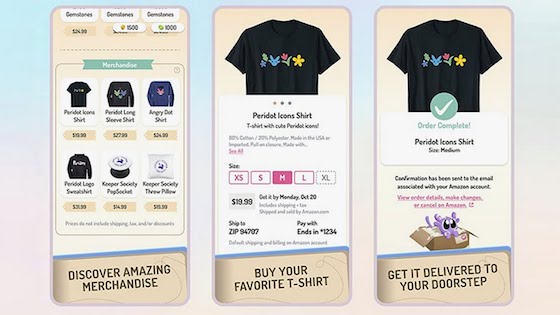Amazon continues to find new places to sell you things. The latest is within mobile games and apps. Announced today, its new “Amazon Anywhere” service brings eCommerce stores into these environments. The idea is that the products sold within those stores can be thematically relevant.
An example of how this will work can be seen in the program’s launch partner, Peridot. This game from Niantic is a follow-up to Pokemon Go and is a sort of cross between that title and Tamagochi-style pet simulators. With an eCommerce element, players can browse and buy game-themed merch.
Altogether, Amazon’s intention is to provide game and app publishers with ways to bring more dimension to their user experiences, while also giving them a monetization mechanism. For the latter, app publishers can get a revenue share that’s aligned with Amazon’s existing affiliate revenue structures.
All of this comes just months after Amazon extended its “Buy with Prime” to merchants. This essentially brings the advantages of Amazon Prime (e.g., free shipping & returns) to third-party apps. Both moves have a common goal for Amazon: To grow its footprint by extending beyond its own walls.
Activation Energy
So how does this all work? Like a lot of things, there are consumer-facing and publisher-facing dynamics. Taking those one at a time, the user-facing flow consists of linking an Amazon account to the game or app that has integrated Amazon Anywhere. From there, users can expedite the shopping process.
That last part is perhaps Amazon Anywhere’s biggest advantage. Because Amazon is so pervasive, most people have accounts they can quickly link. This mitigates “activation energy” such as signing up for a new eCommerce account, billing, and shipping info… which no one wants to do on a small touchscreen.
The UX is also meant to give users a one-stop shop (literally) to buy merch. This not only has a convenience factor in being able to shop without leaving the app, but it’s highly targeted. In other words, players of a given game are prime targets for branded merch, which can boost conversions.
That brings us to the publisher-facing dynamics. The biggest selling point there is supplementary revenue, as noted, through a customized store. Setup is also easy as customization happens through curating any products from anywhere on Amazon, including a given publisher’s own branded merch.

Another Level
Stepping back, Amazon Anywhere integrations could be additive to certain apps. For example, Peridot is a fitting environment as the game’s AR orientation – again, like Pokemon Go – is all about blending the physical and digital. Buying physical goods within a game takes that concept to another level.
Those organic integrations will be the name of the game, as an eCommerce store may otherwise be perceived by users as blatant commercialism. For example, anything that is fan-based makes sense to integrate a merch store. This could fit well for event ticketing apps or sports-centric apps.
Besides aligning the user experience for additive integrations, Amazon Anywhere could lower barriers for app publishers to have an eCommerce component. The plug & play nature of the program could be appealing to smaller app publishers who don’t have the resources nor ability to do so on their own.
In that way, Amazon Anywhere could be most competitive with platforms meant to democratize eCommerce for third-party merchants, namely Shopify. We’ll be watching to see if Amazon’s move makes a dent – in that competitive sense and in its goal to extend itself beyond the walls of Amazon.com.



